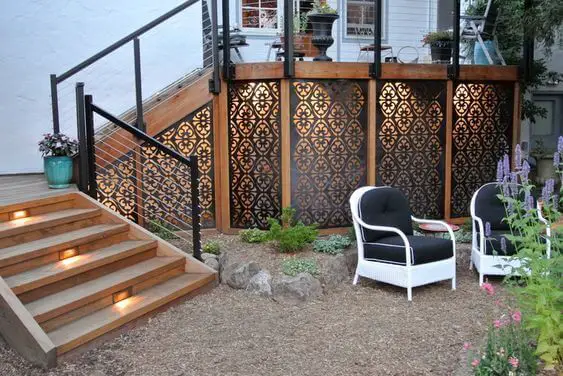Pets are an essential part of many families, but they can also pose a challenge when it comes to home decor. A well-decorated home can quickly be ruined by pet damage or messes.

Photo by Sabina Sturzu on Unsplash
However, this doesn’t mean you have to compromise on style in order to accommodate your furry friends.
With a few simple tips and tricks, you can create a stylish and functional pet-friendly home that is both practical and beautiful. In this guide, we’ll cover some essential tips for making your home decor pet-friendly, from selecting durable furniture to choosing the right flooring and decor elements that can withstand pet wear and tear.
Contents
Creating Solutions for Common Pet Problems
Pets are wonderful companions, but they can also bring some challenges to your home. From shedding to scratching, pets can cause damage to your furniture and flooring, leaving you with costly repairs.
However, with a little bit of planning and creativity, you can create solutions for common pet problems at home.
Odors
Pets can leave behind unpleasant smells that can linger in your home. Regular cleaning and airing out your home can help, as can using odor-neutralizing sprays and air fresheners.
Since the smells usually come from the litter boxes, consider getting hidden ones. They keep the odors away, but also take the litter boxes out of your sight.
Hidden Litter Boxes
One common pet problem is the unsightly litter box. While necessary for cats, litter boxes can be an eyesore in your home.
Fortunately, there are several ways to hide your cat’s litter box while still making it easily accessible for them.
- Concealed Litter Box Furniture: There are a variety of litter box furniture options available that allow you to conceal your cat’s litter box while providing a functional piece of furniture. These units can double as benches, end tables, or cabinets to blend seamlessly into your home decor.
- Built-In Litter Box Compartments: If you’re planning a renovation or remodeling project, consider building a built-in litter box compartment into your cabinets or furniture. This allows you to keep the litter box hidden away while still maintaining easy access for cleaning.
- DIY Hidden Litter Box: For a more budget-friendly option, try creating your own hidden litter box using a storage bin or cabinet with a cut-out entrance. You can also add decorative elements such as curtains or plants to disguise the litter box further.
By hiding your cat’s litter box, you can maintain a cleaner and more stylish home while still ensuring your cat has a comfortable and accessible place to do their business.
Scratching and Chewing
Dogs and cats can be notorious for scratching and chewing on furniture and other household items. To prevent this, provide your pet with appropriate outlets for their natural behaviors. Offer plenty of chew toys for dogs or scratching posts for cats. You can also use deterrent sprays or covers to protect furniture and surfaces from pet damage.
Shedding
Pet hair can be a nuisance, especially for those with allergies. Regular grooming and brushing can help reduce shedding, as can investing in high-quality vacuums and air filters designed to capture pet hair. Consider selecting furniture and flooring materials that don’t show pet hair as easily, such as leather or tile.
Stains and Messes
Accidents happen, and pets can leave behind stains and messes that are difficult to clean up. To prevent this, train your pet to use designated areas for eating and drinking and to go outside for potty breaks. Use stain-resistant fabrics and materials for furniture and flooring, and keep cleaning supplies on hand for quick clean-ups.
By creating solutions for common pet problems at home, you can maintain a comfortable and functional living space for both you and your furry friends. Remember to prioritize safety and practicality when selecting furniture and decor, and always keep your pet’s needs in mind when designing your home.
Choosing Pet-Safe Materials
Choosing the right materials is a key step in designing pet-friendly furniture, floors and other home decor.
The best fabrics are durable, resistant to staining and easy to clean. Even the tidiest pets track in dirt, throw up or have accidents, so your choices should be able to stand up to some wear and tear.
Avoid woven fabrics, which can easily snag claws and teeth and are harder to wipe down than solids. A synthetic material like microfiber is a good option because it’s soft and velvet-like with a tight weave that resists claw scratches. It’s also stain-resistant and odor-resistant.
Bamboo flooring is another durable choice, especially when layered with cork or rubber underlayment. It’s easier to maintain than natural hardwood and is less prone to moisture damage.
When it comes to textiles, organic cotton is a good choice for toys, bedding and halters because it’s non-GMO and grown without pesticides and synthetic fertilizers, which are harmful for pets and the surrounding environment.
Hemp, meanwhile, is a sustainable crop that’s antimicrobial, anti-dust mite and floats, which makes it ideal for fetching toys. And for pet bedding, consider regenerated cotton – also known as recycled shoddy – which keeps pre- or post-consumer cotton out of landfills. The fabric is then woven and used to make bedding, pillows and accessories.
This is a great alternative to PVC, which is considered the ‘poison plastic’ because it leaches toxic chemicals when heated and licked or chewed by animals.
Designing a Pet-Friendly Space
Pets have proven to be a wonderful stress-reliever during this tumultuous time, and many people are adopting furry friends in droves.
Sadly, our lovable companions’ needs often clash with our design aesthetic, leading to some pretty frustrating home decor problems.To avoid this, make smart design choices that find the right balance between your style and your pets’.
This may include incorporating dog beds into your design plans to work with the rest of your furnishings, or sourcing pet supplies that blend in with your decor. You could even consider a sleek, modern gate to keep your dog or cat away from furniture or areas they shouldn’t be in.
If you’re building a new home, or renovating an existing one, look for ways to incorporate pet-friendly features in underused spaces.
For example, an unused bookshelf could hold a kennel, and a rarely used storage area can become a pet play zone or dog bathing station. And a doorway space can be a good place to store pet wipes, treats and other essentials.
Final Thoughts
Creating a pet-friendly home doesn’t have to mean sacrificing style or comfort. With a few simple tips and tricks, you can create a beautiful and functional home that accommodates your furry friends.
Remember to prioritize safety, practicality, and the needs of your pets when designing your home, and don’t be afraid to get creative and think outside the box.
By creating a pet-friendly home, you can enhance the bond you share with your furry companions while enjoying a comfortable living space that suits the needs of your entire family.



